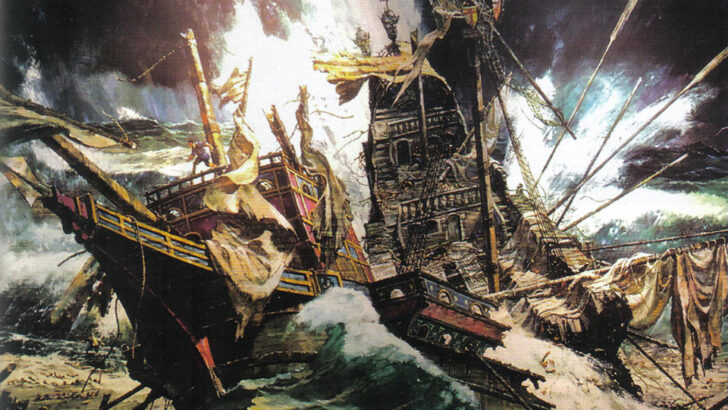1588: The Spanish Armada and the 24 Ships Lost on Ireland’s Shores
by Michael B. Barry (Andalus Press, €23.99 / £19.99)
Legends of “Spanish gold” haunt the western shores of Scotland and Ireland, from Tobermory to the Blasket Sound.
As his subtitle indicates a good part of Michael Barry’s space in his latest book is taken up with tracking down and unravelling the often complicated reports and claims made over the centuries about the twenty-four Irish shipwrecks, which will provide Irish readers with a localised interest in the Spanish Armada. But only as part of the aftermath of what was the original Spanish plan, the invasion of England itself.
Back in 1988 a plethora of books about the Armada were published in England, for the most part reflecting the long standing patriotic celebration of Queen Elizabeth I, Francis Drake and Walter Raleigh.
Vast
However, since then a vast amount of new material has appeared in Spanish, derived for the most part from the great maritime archive in Madrid. With his grasp of Spanish Michael Barry has been able to take advantage of these publications (little known in England) to write a book for a popular readership which is truly based on the very latest scholarship. So if you want a book to read to understand what happened in 1588 this would be the one to begin with.
The essential heart of this book is what the Spanish really intended. Their scheme was to use their huge fleet to gain control of the Channel and part of the North Sea, and under its protection to transfer from the Spanish Netherlands their soldiers in barges across the water to land at Margate. This has always seemed to me to be a strange notion.
A little while ago, researching the wreck of the Deutschland about which G. M. Hopkins wrote his famous poem, I found that it was not a unique incident. In the days of sail over three hundred ships a year were being lost along the Channel and the lower North Sea. It was one of the most dangerous sea areas in the world.
The idea that one could land troops at Margate — Margate of all places — and then simply march on London, capture the Queen and remove her from the throne, installing a selected Catholic monarch in her stead, was unlikely to have ever succeeded.
Neutralise
It seems that the Spanish did not plan to occupy the whole country, merely to neutralise it and stop English pirates preying on the Spanish ships carrying gold and silver from America to Europe. But the new aristocratic elite in Tudor England, grown rich on lands confiscated from the Church, were unlikely to have given in easily. This project would surely have become King Philip’s “March on Moscow” if the Spanish had got ashore.
As it was, as Barry describes in fresh detail, the Armada was damaged by fire-ships at the battle of Gravelines, and the decision was made to return to Spain, sailing north around Scotland and striking out into the Atlantic, well away, it was planned, from the coastlines of Scotland (then a separate country) and Ireland.
Barry emphasises that the Armada was not defeated in the conventional sense; it merely “retreated in good order” as the military say: only a fraction of its ships were lost, the other two thirds reached Spain safely. So though it was not a victory for the Spanish, it was no spectacular victory for England. It was all down in any case to what became known as the “Protestant Wind” that scattered the Spanish fleet.
Deceived
But it has been argued that the navigators were deceived by the maps of Ireland, on which our west coast was misdrawn. Coming down from Scotland the Spanish ran into the north coast of Mayo, which they did not know was there, which meant disaster and death for some ships.
This is all vividly narrated. But one aspect Barry passes over. The defeat of the Armada gave England a false belief that the country could not be invaded”
Even for the Spaniards who got ashore there was little welcome. Some got away to Scotland, among them Francisco de Cuéllar, whose narrative of his misadventures gives a rather unflattering description of Gaelic society in that time. Well over 1,110 Spaniards, it was reported to the Queen, were “put to the sword”.
This is all vividly narrated. But one aspect Barry passes over. The defeat of the Armada gave England a false belief that the country could not be invaded. Belloc in his book about warfare in England refused to discuss the historic invasions of the country. Later foreign armies might land in Ireland or Scotland, but they were defeated. England was safely secured by her surrounding sea.
In the time of Napoleon the Keeper of the State Paper Office, John Bruce, was ordered by Prime Minister Pitt to draw up a report on the preparations made in 1588, in case they might have some help in defending England from the revolutionary French. (Barry does not refer to this report, or to a later publication in 1902 by a French scholar, Edouard Desbrière.) When the two World Wars came the British government went about developing its plans without reference to 1588.
Barry may not mention these odd aspects of the aftermath of the Armada, but he finds room in his crisp richly illustrated account for everything else. Altogether a great read.
This, by the way, is the Irish edition; there is also a Spanish edition appearing simultaneously, and Spanish language books can have as large a universal sale as anything in English, so good luck with that.


 Peter Costello
Peter Costello Wreck of the Girona on Antrim coast
Wreck of the Girona on Antrim coast 